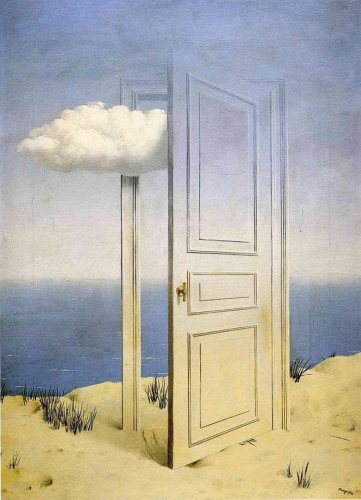René Magritte letters to Michel Foucault
Translated and Edited by James Harkness. University of California Press
May 23, 1966
Dear Sir,
It will interest you, I hope, to consider these few reflections relative to my reading of your book Les Mots et les choses...
The words Resemblance and Similitude permit you forcefully to suggest the presence-utterly foreign of the world and ourselves.
Yet, I believe these two words are scarcely ever differentiated, dictionaries are hardly enlightening as to what distinguishes them.
It seems to me that, for example, green peas have between them relations of similitude, at once visible (their color, form, size) and invisible (their nature, taste, weight) . It is the same for the false and the real, etc. Things do not have resemblances, they do or do not have similitudes.
Only thought resembles. It resembles by being what it sees, hears, or knows ; it becomes what the world offers it.
It is as completely invisible as pleasure or pain. But painting interposes a problem : There is the thought that sees and can be visibly described. Las Meninas is the visible image of Velasquez’s invisible thought. Then is the invisible sometimes visible ? On condition that thought be constituted exclusively of visible images.
On this topic, it is evident that a painted image intangible by its very nature hides nothing, while the tangibly visible object hides another visible thing—if we’ trust our experience.
For a time a curious priority has been accorded “the invisible“ owing to a confused literature, whose interest vanishes if we remember that the visible can be hidden, but the invisible hides nothing ; it can be known or not known, no more. There is no reason to accord more importance to the invisible than to the visible, nor vice versa.
What does not “lack” importance is the mystery evoked infact by the visible and the invisible, and which can be evoked in principle by the thought that unites “things” in an order that evokes mystery.
Permit me to bring to your attention the enclosed reproductions by Rene Magritte of paintings, which I executed without looking into the original purposes of their painters.
Sincerely yours,
Rene Magritte
June 4, 1966
Dear Sir,
Why did I see coffins where Manet saw pale figures ? Your question regarding my painting Perspective : Le Balcon de Manet implies its own answer : The image my painting reveals where the decor of the “Balcony” is suitable for placing coffins.
The “ mechanism” at work here could serve as the object of a scholarly explanation of which I am incapable. The explanation would be valuable, even irrefutable, but the mystery would remainundiminished.
The first painting called “ Perspective” was a coffin situated on a stone in a landscape.
The “Balcony” is a variation on it ; before, there were other versions : Perspective : Madame Recamier, de David and Perspective : Madame Recamier, de Gerard. A variation with, for example, the setting and characters of L’Enterrement d’Ornans would heighten the parody.
I believe it should be pointed out that the paintings named Perspectives have a connotation distinct from the two ordinary meanings of the word. This word and others have a precise meaning in a context, but the context you show it better than anyone else in Les Mots et les choses can say nothing is confused, save the mind that imagines an imaginary world. I am pleased that you recognize a resemblance between Roussel and whatever is worthwhile in my own thought. What he imagines evokes nothing imaginary, it evokes the reality of the world that experience and reason treat in a confused manner.
I hope to have the opportunity of meeting you during the exhibit I will have near Paris, at lolas, toward the end of the year.
Sincerely yours,
Rene Magritte
— Notes
Two Letters by Rene Magritte
1 . Las Meninas , “the servants, “ was the frontispiece for Les Mots et les choses and the topic of its first chapter.
 Regard sur l’image
Regard sur l’image
